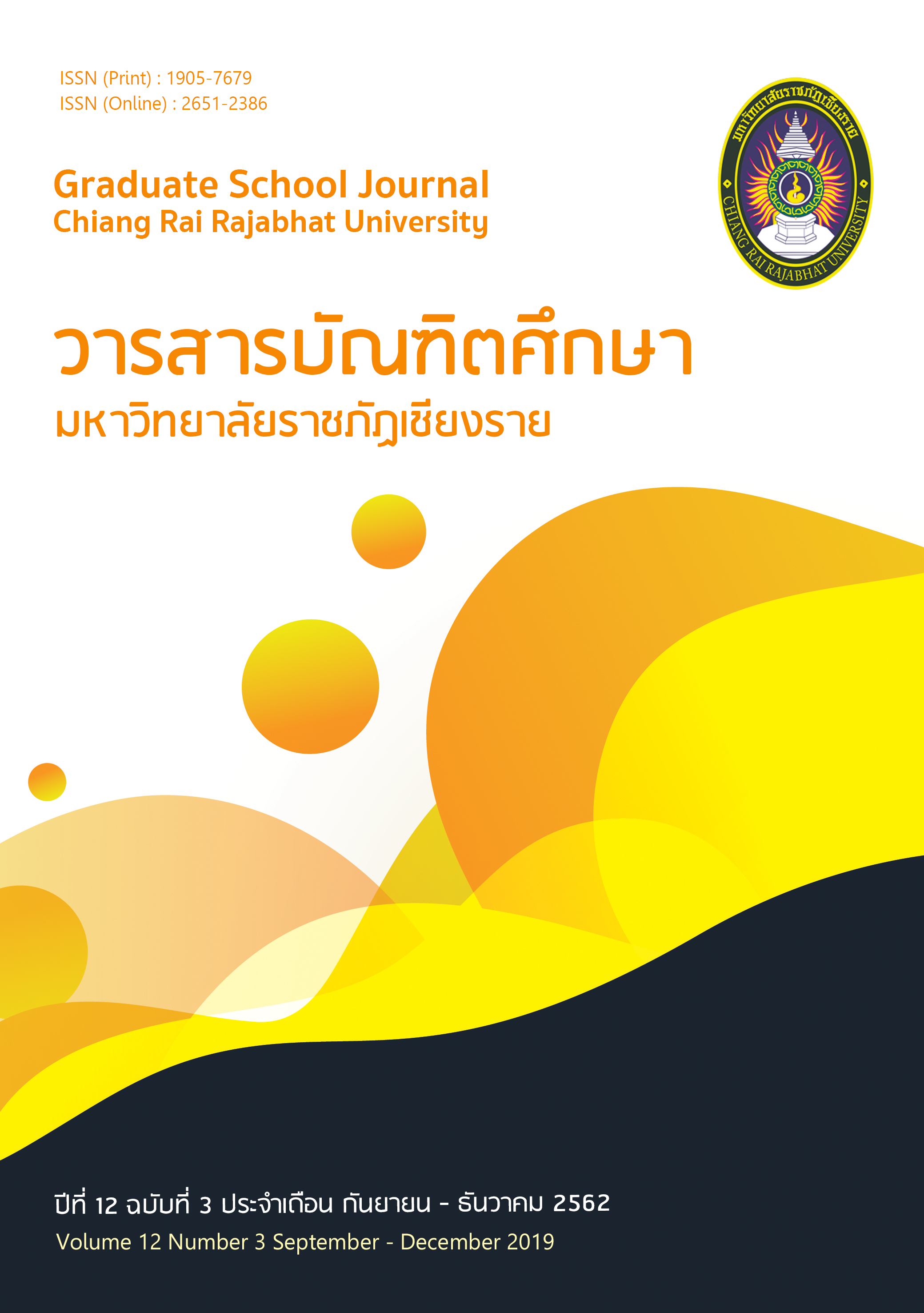Chinese-Thai Related Lexicons in “Earth, Water, Wind, Fire” Semantic Field
Main Article Content
Abstract
In this article, the analysis of Chinese-Thai related lexicons in “earth, water, wind, fire” semantic field was conducted using the comparison method in historical linguistic. The findings show that Chinese-Thai related lexicons in “earth, water, wind, fire” semantic field is cognates. In the “earth” semantic field, “土”and [laːC1], “社”and [lakDS1] originated from Proto Austronesian [*daReq] or Proto Austronesian-Ongan [*daReq/*taReq]. In the “water” semantic field, “水”and [huajC1] originated from Proto Austronesian-Ongan [*qwaHiR]. In the “wind” semantic field, “风”and [lomA4] originated from Proto Trans-New Guinea [*pinVm]. In the “fire” semantic field, “火”and [fajA4] originated from Proto Austronesian [*Sapuy]. Chinese-Thai related lexicons in “earth, water, wind, fire” semantic field shows that Chinese, Tai, Austronesian, Ongan, and Trans-New Guinea languages are possibly genetically related.
Article Details
บทความที่ได้รับการตีพิมพ์เป็นลิขสิทธิ์ของวารสารมหาวิทยาลัยราชภัฎเชียงราย
ข้อความที่ปรากฏในบทความแต่ละเรื่องในวารสารวิชาการเล่มนี้เป็นความคิดเห็นส่วนตัวของผู้เขียนแต่ละท่านไม่เกี่ยวข้องกับมหาวิทยาลัยราชภัฎเชียงราย และคณาจารย์ท่านอื่นๆในมหาวิทยาลัยฯ แต่อย่างใด ความรับผิดชอบองค์ประกอบทั้งหมดของบทความแต่ละเรื่องเป็นของผู้เขียนแต่ละท่าน หากมีความผิดพลาดใดๆ ผู้เขียนแต่ละท่านจะรับผิดชอบบทความของตนเองแต่ผู้เดียว
References
เฉลิม ยงบุญเกิด. (2512). ภาษาไทย ภาษาจีน. พระนคร: โรงพิมพ์ศูนย์การพิมพ์.
ภิญโญ จิตต์ธรรม. (2513). ภาษาถิ่น. สงขลา: วิทยาลัยครูสงขลา และ วิทยาลัยการศึกษาสงขลา.
Benedict, Paul K. (1975). Austro-Thai language and culture, with a glossary of roots. Connecticut: Hraf Press.
Blevins, J. (2007). A long lost sister of Proto-Austronesian-Ongan? Proto-Ongan, mother of Jarawa and Onge of the Andaman islands. Oceanic Linguistics, 46(1), 154-198.
Blust, R. and Trussel, S. Austronesian comparative dictionary, web edition. Retrieved April 4, 2019, from https://www.trussel2.com/ACD/
Brown, Marvin J. (2007). From ancient Thai to modern dialects. Bangkok: White Lotus.
Conrady, A. (1896). Eine Indochinesische Causativ-Denominativ-Bildung und ihr Zusammenhang mit den onaccenten: Ein Beitrag zur Vergleichenden Grammatik der Indochinesischen Sprachen, Insonderheit des Tibetischen, armanischen, Siamesischen und Chinesischen. Leipzig: Otto Harrassowitz.
De Lacouperie, T. (1887). The languages of China before the Chinese. London: David Nutt. Greenhill, Simon J. A database of the languages of New Guinea. Retrieved April 4, 2019, from https://transnewguinea.org/
Greenhill, Simon J., Blust, R. and Gray, R. D. The Austronesian basic vocabulary database: From bioinformatics to lexomics. Retrieved April 4, 2019, from https://abvd.shh. mpg.de/austronesian/
Grierson, George A. (1904). Linguistic survey of India(II): Mon-Khmer and Siamese-Chinese families (including Khasi and Tai). Calcutta: Office of the Superintendent of Government Printing.
Maspero, H. (1926). Les Origines de la Civilisation Chinoise. Annales de Géographie, 35, 135-154.
Maspero, H. (1965). La Chine Antique. Paris: Universitaires de France Presses.
Ostapirat, W. (2000). Proto-Kra. Linguistics of the Tibeto-Burman Area, 23(1), 1-251.
Pawley, A. (2006). The chequered career of the Trans-New Guinea hypothesis : Recent research and its implications. In Pawley A., Attenborough R., Hide R. And Golson J., Papuan past : Cultural, linguistic and biological histories of Papuan-speaking peoples. pp. 67-107. Canberra: Pacific Linguistics Research School of Pacific and Asian Studies, the Australian National University.
Pittayaporn, P. (2009). The Phonology of Proto-Tai. (Dissertation). New York: Cornell University. SEAlang. Southeast Asian Languages Library. Retrieved on 4 April 2019, from https://sealang. net/library/
Shafer, R. (1955). Classification of the Sino-Tibetan languages. WORD, 11(1), 94-111.
Wulff, K. (1934). Chinesisch und Tai : Sprachvergleichende Untersuchungen. København: Levin & Munksgaard.
陈月明. (2018). 汉泰对应词研究综述. 泰国农业大学中国学研究期刊, 11(2), 28-65.
丁邦新. (2005). 汉语史研究: 纪念李方桂先生百年冥诞论文集. 台北: 中央研究 院语言学 研究所.
董为光. (1984). 汉语侗台语语源联系举例. 语言研究, (2), 205-214.
国学大师网. 国学大师——古典图书集成. Retrieved on 4 April 2019, from https://www.guoxuedashi.com/
梁敏、张均如. (2004). 从汉台语言的数词是否同源说起. 民族语文, (2), 52-56.
李方桂. (2011). 侗台语论文集. 北京: 清华大学出版社.
罗美珍. (1983). 试论台语的系属问题. 民族语文, (2), 30-40.
罗美珍. (1994). 三论台语的系属问题. 民族语文, (6), 1-11.
潘悟云. (2000). 汉语历史音韵学. 上海: 上海教育出版社.
潘悟云. (2011). 汉藏语与澳泰语中的“死”. 民族语文, (6), 3-8.
潘悟云. (2013). 东亚语言中的“土”与“地”. 民族语文, (5), 3-12.
王士元(主编). (2005). 汉语的祖先. 李葆嘉, 译. 北京: 中华书局.
吴安其. (2002). 汉藏语同源研究. 北京: 中央民族大学出版社.
吴安其. (2009). 侗台语的发生学关系. 语言研究, 29(4), 13-30.
邢公畹. (1989). 论汉语台语“关系字”的研究. 民族语文, (1), 12-27.
邢公畹. (1991). 关于汉语南岛语的发生学关系问题——L·沙加尔《汉语南岛 语同源论》述评补证. 民族语文, (3), 1-14.
邢公畹. (1999). 汉台语比较手册. 北京: 商务印书馆.
郑张尚芳. (2013). 上古音系. 上海: 上海教育出版社.

